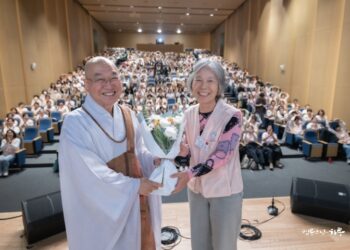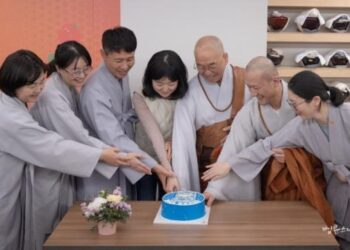Aug 5, 2025 – Day 3 of the Northeast Asian History Tour, Amnokgang (Yalu) River, Changbai, Erdaobaihe
Hello. This is the third day of the Northeast Asian History Tour. Today, Sunim traveled along the Amnokgang(Yalu) River, looking at North Korean territory across the river and sharing many stories about ‘the reality of North Korea.’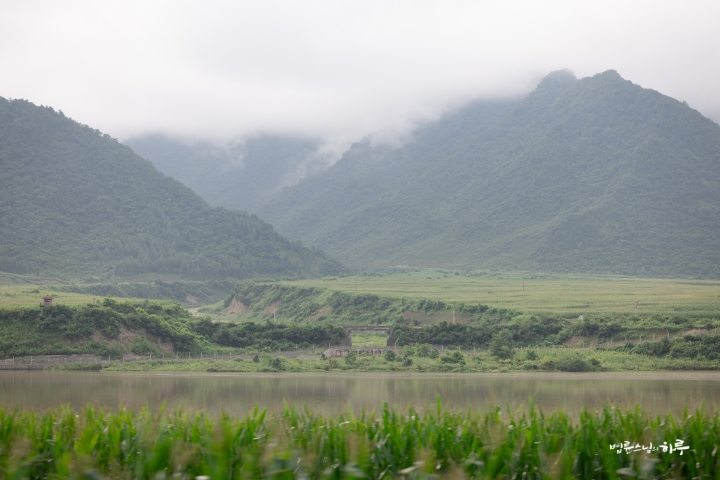
The tour group left their accommodations at 4:40 AM and headed to the early morning market in downtown Ji’an. Each person had breakfast at the market and also bought food for lunch.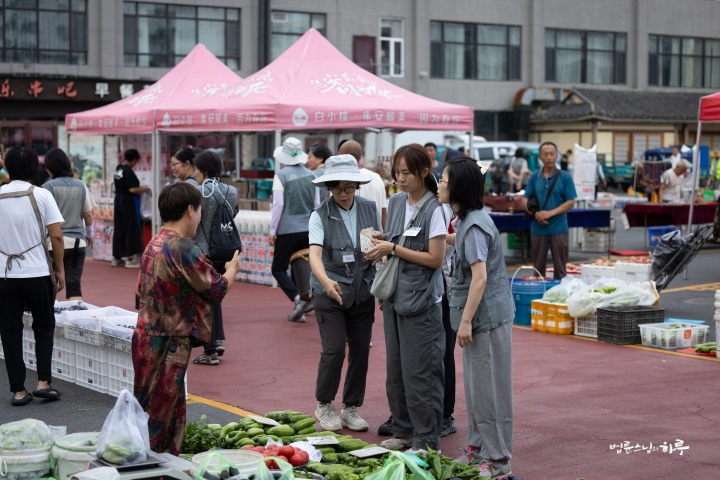
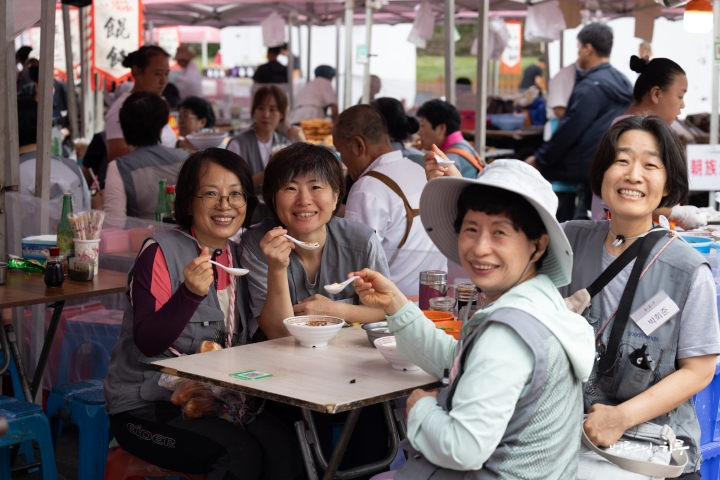
Sunim also bought porridge and ate breakfast standing on the street.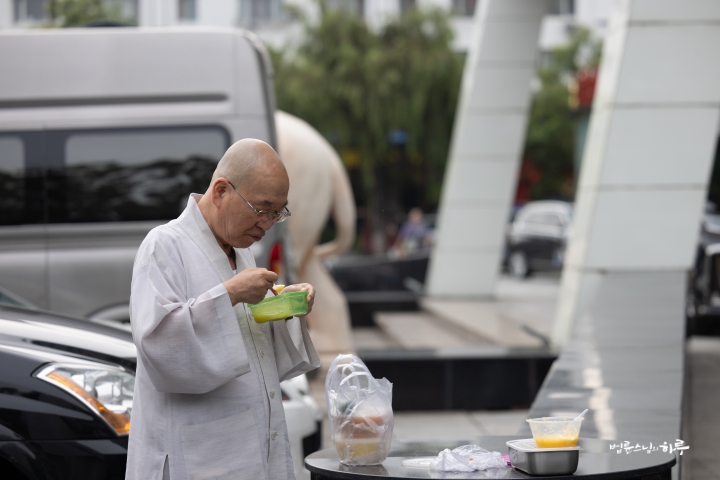
After a quick meal at the market, the group departed Ji’an at 5:30 AM and headed to Guodong Great Cave.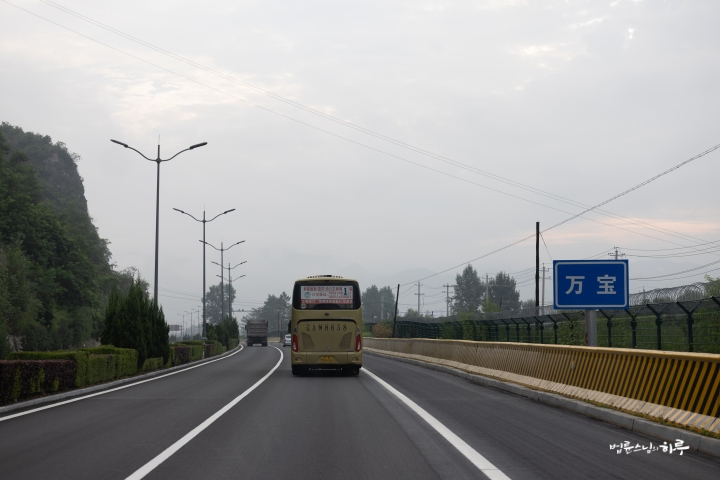
As the bus departed, Sunim began explaining today’s itinerary and information about Guodong Great Cave through the transceiver.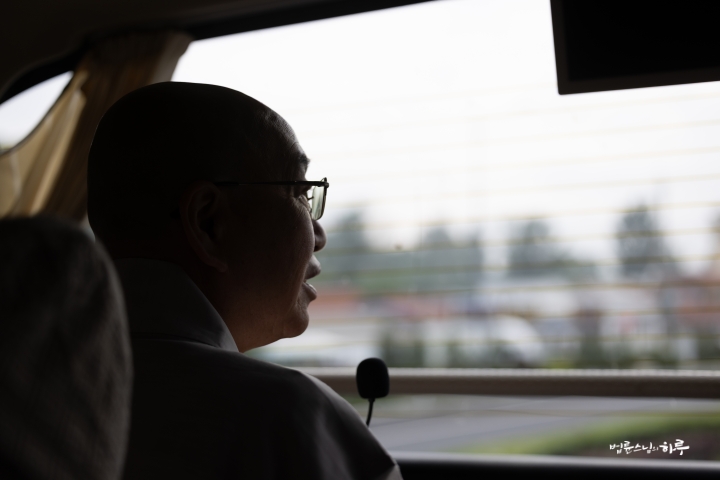
“We are now leaving Ji’an and heading east of Gungnaeseong. Gungnaeseong was the capital of Goguryeo. About 17 kilometers east of there is a place called Guodong Great Cave. As the name suggests, it’s a large cave at the eastern edge of Goguryeo, a sacred place where the Goguryeo king offered sacrifices to heaven once a year. The exact location of this cave was unknown for a long time, but it was recently discovered, and we have been visiting it during our history tours.
Now we are heading north along the Amnokgang(Yalu) River. If you look out the window, you can see North Korea’s Manpo City far across the river. Do you see that railway track? This railway connects to Manpo in North Korea. 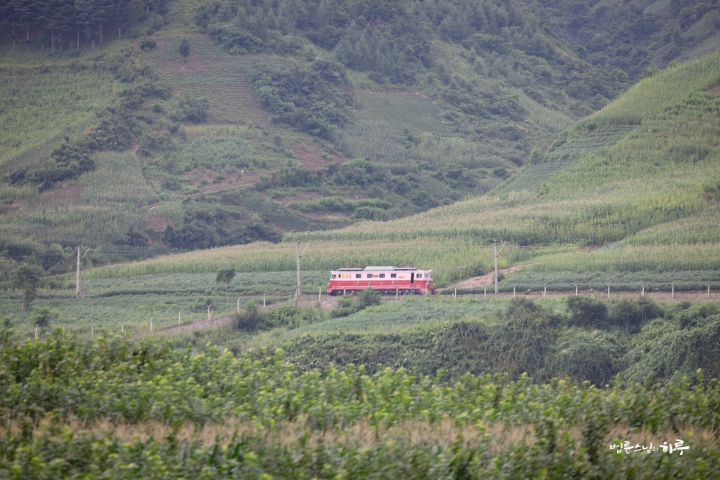
The mountains visible across the river are all North Korean mountains. The closest area you can see is Manpo City. The road we’re traveling on now was unpaved just 10 years ago, and it was very difficult to travel because the road was narrow and in poor condition. When it rained heavily, the river would often flood and the road would be closed. However, China’s infrastructure investment in recent years has been tremendous. Changes are happening so rapidly that people say things change overnight. Do you see those buildings across the river? North Korea has also seen a lot of construction recently. There used to be almost no such buildings, but now they’re quite noticeable. 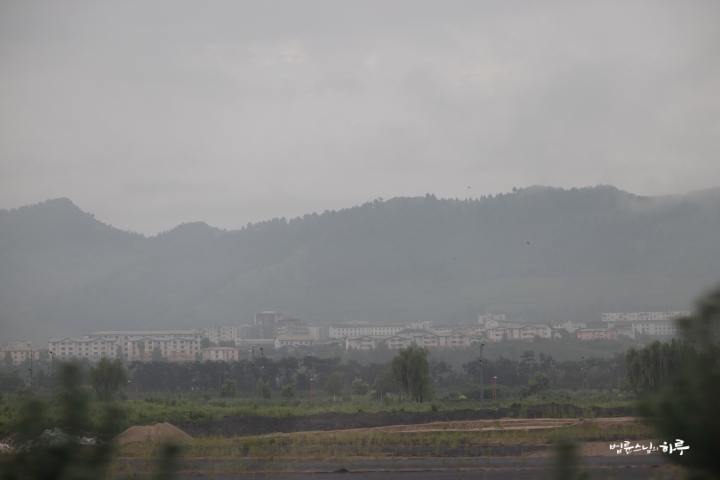
China has built bridges and constructed customs offices, cities, and factories in almost all areas bordering North Korea. They have been making thorough preparations for North Korea’s opening for over a decade. 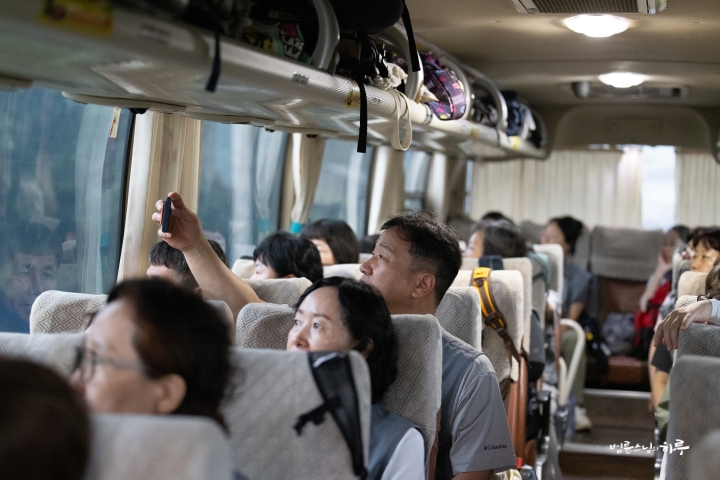
What you see on the right is a North Korean cement factory. This factory, which had been shut down for a while, has started operating again in the past decade or so. Although the dust from the factory operation is severe, we actually feel happy seeing it and say, ‘Wow, the factory is running!’ 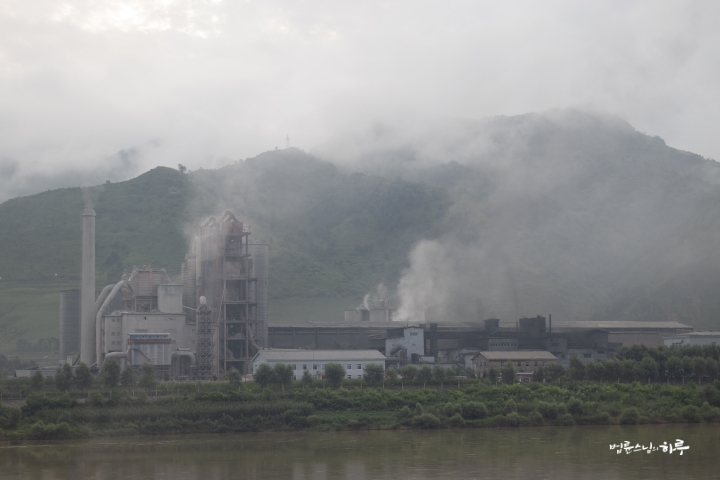
The river you see outside the window right now is the Amnokgang(Yalu) River. Barbed wire fences have been installed on both sides of the river. In the past, there were no such fences on either the Chinese or North Korean side. As you can see now, barbed wire fences have been completely installed on both sides, and there are guard posts as well. It’s been set up just like our country’s DMZ.” 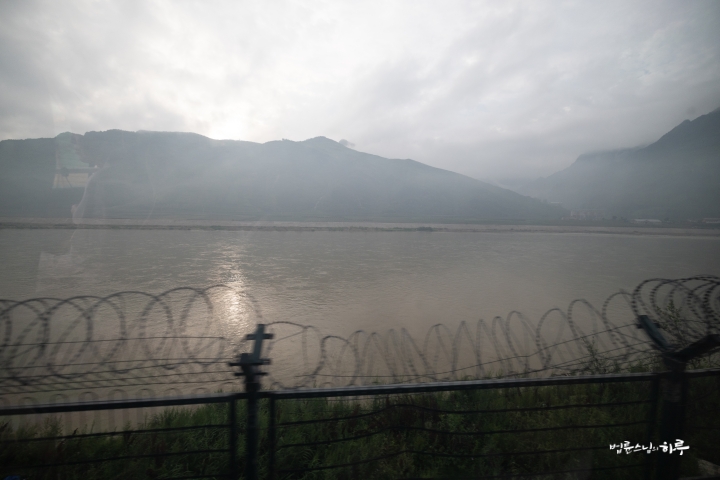
On the way to Guodong Great Cave, North Korea along the Amnokgang(Yalu) River appeared so close it seemed within reach.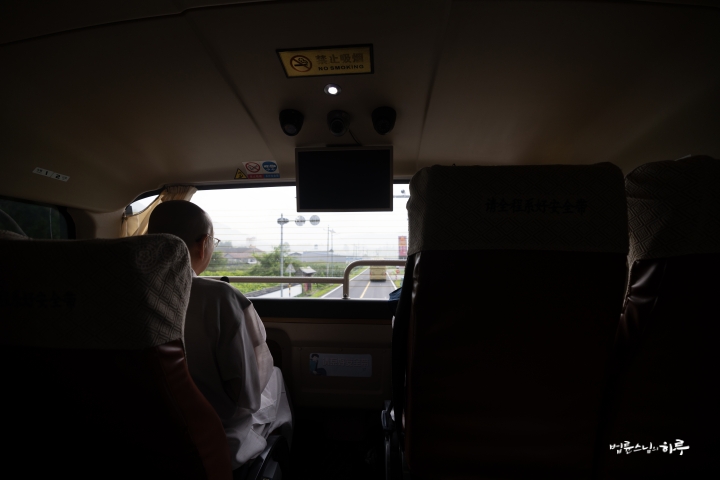
“In summer, many people come out to this riverbank, but today no one is visible, perhaps because of the rain. On the Chinese side of the riverbank, they have built embankments, constructed roads on top, and developed various facilities. The riverbank is a kind of shared area, but with China developing the riverbank like this, which way do you think the water will flow when there’s a flood? It will inevitably flow toward the North Korean side. Because North Korea has almost no embankment facilities. When heavy rain comes, damage on the North Korean side will be greater than before. Since the embankment facilities are inadequate, flood damage is worse than in the past.
There are also cruise boats here. When unification happens or the border opens, you’ll be able to take a boat from here up to Hyesan. Currently, barbed wire fences are installed on both the North Korean and Chinese sides to prevent crossing, but in the past, this was an area where residents would come and go like neighboring villages. During the Arduous March period, there are stories of people crossing with a puppy in their arms on tire tubes to sell it and return. If you go upstream, the river narrows to become like a stream, making it easy to cross.” 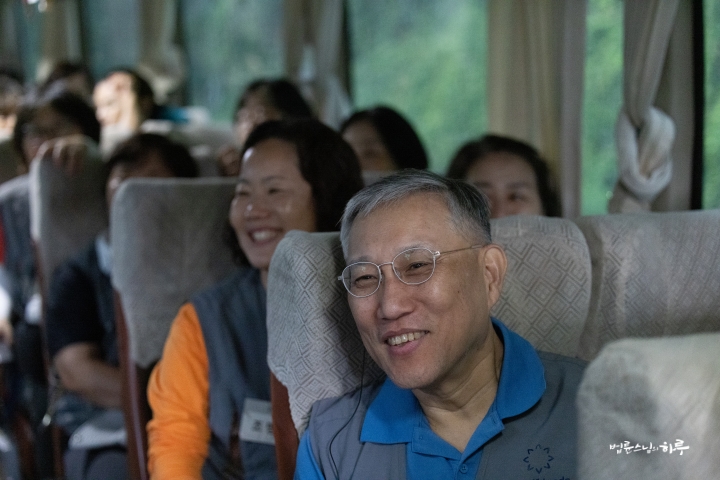
As they listened attentively to Sunim’s explanation, they arrived at Guodong Great Cave before they knew it.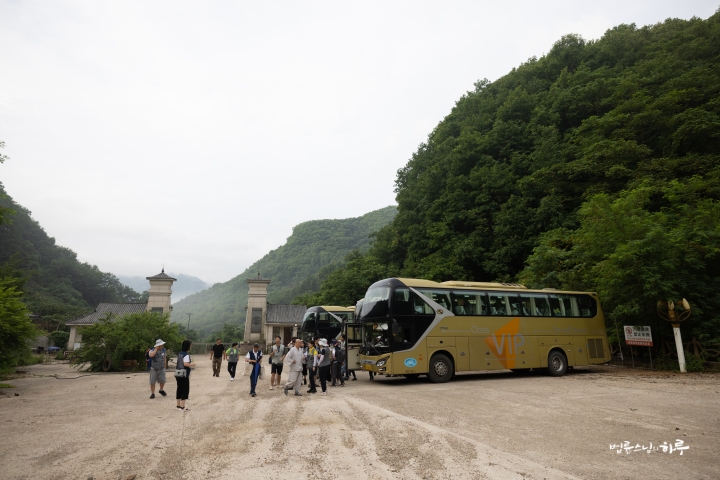
At 6 AM, they got off at the parking lot and began climbing in single file along the mountain path toward Guodong Great Cave. However, suddenly a staff member came running and informed them that according to Chinese public security instructions, they could not go any further and had to turn back.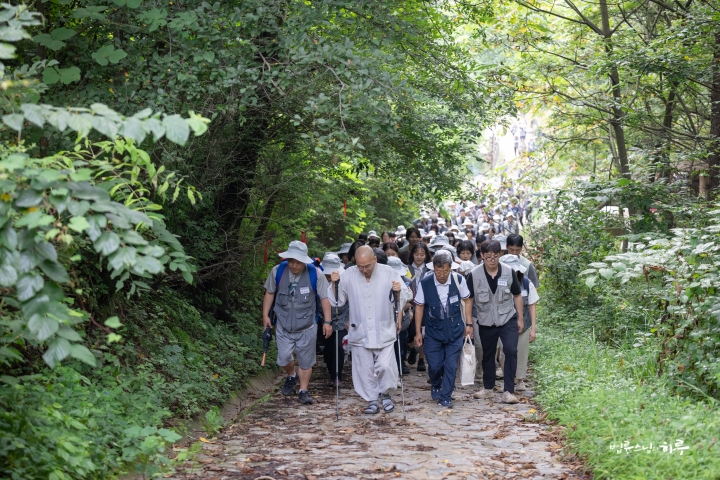
After climbing the mountain path for just 20 minutes, they regrettably had to turn back. Sunim also expressed his disappointment.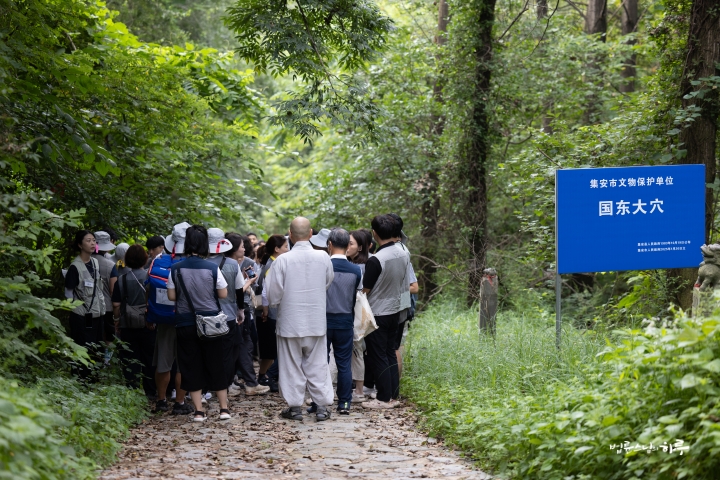
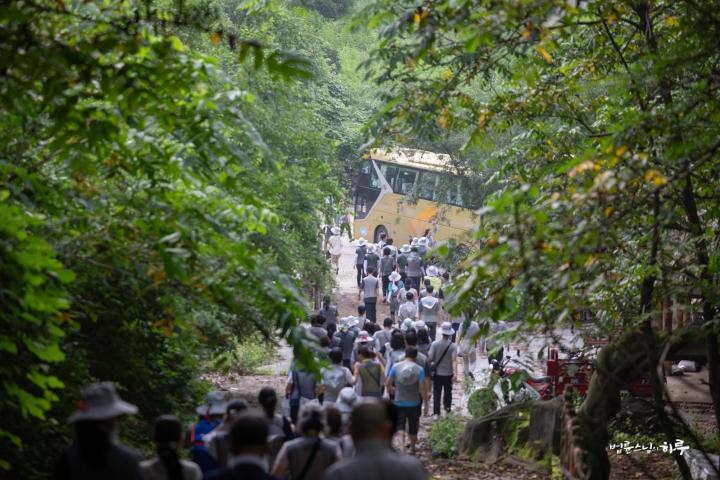
“When you arrive at Guodong Great Cave, there is a cave called ‘Tongcheonmun’ (Gate to Heaven) because it is said to connect with the sky. It’s a naturally formed rock cave that seems to connect with heaven. Since it’s a completely natural cave untouched by human hands, there should be no legal issues at all, but they won’t let us go. It’s unfortunate, but we’ll turn back.”
Leaving their disappointment behind, they boarded the bus again and continued along the Amnokgang(Yalu) River. As they traveled upstream on it, the view of North Korea across the river became increasingly clear.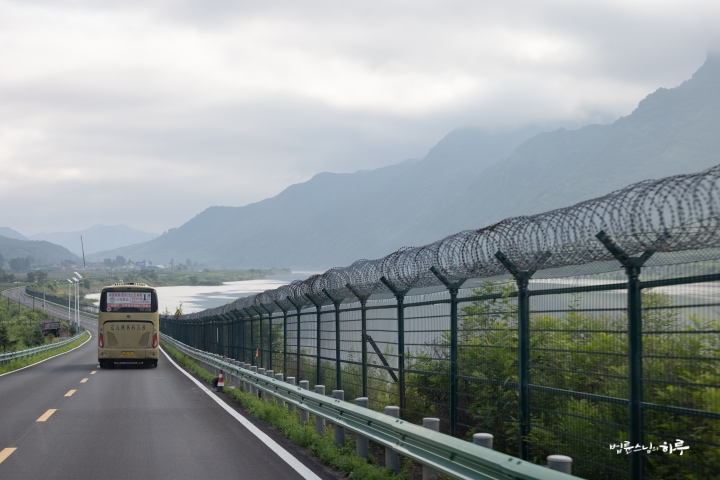
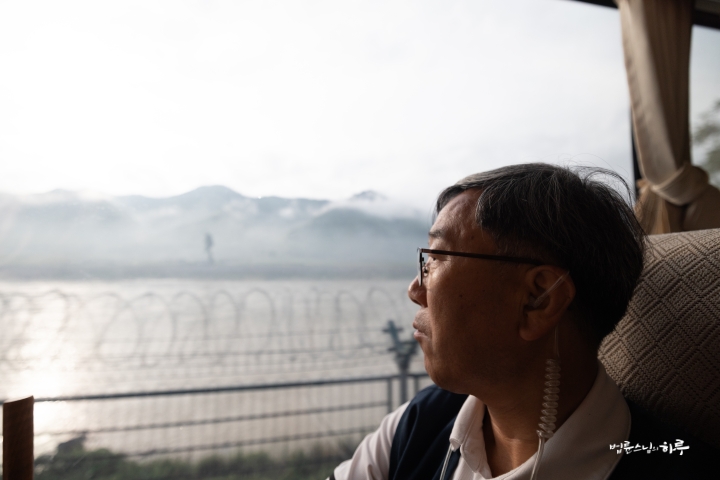
They arrived at the Unbong checkpoint at 7 AM, where the inspection took a considerable amount of time. However, just as they were about to depart after completing all inspections, the travel agency informed them that a landslide had blocked the road a little further ahead.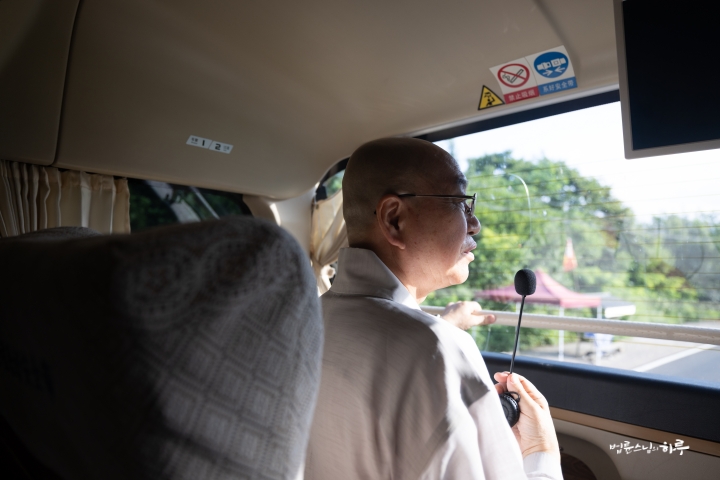
“Due to a landslide, access to the Amnokgang(Yalu) River area has become difficult, so we’ll detour around Unbong Dam. What we’re looking at across the river right now is Manpo City in North Korea’s Chagang Province.
The Amnokgang(Yalu) River is approximately 790km in total length. While the straight-line distance from Sinuiju to Mount Baekdu is about 400km, following the waterway extends to about 800km. This shows how the river winds like a snake. Especially the upper region from Manpo to Haesanjin is called a meandering river because it curves so much. When the river makes a full turn, at certain points North Korean land appears on the Chinese side and Chinese land appears on the North Korean side – that’s how complex it is.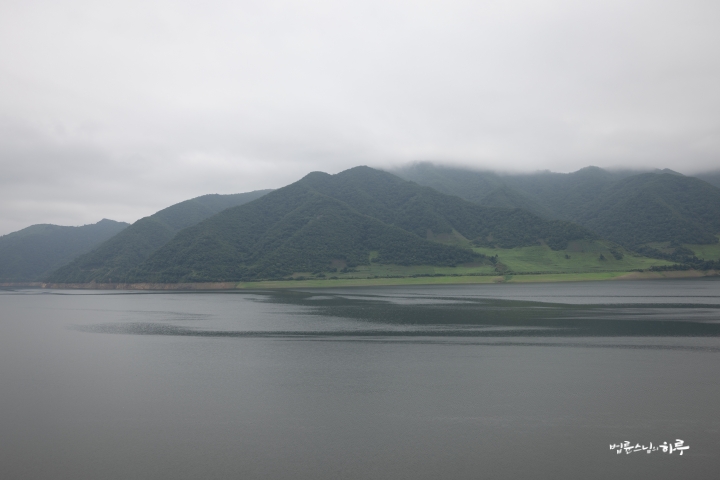
In this river, since the Japanese colonial period, logs cut from Mount Baekdu were made into rafts and floated downstream. When Supung Dam was built, they couldn’t reach the West Sea and were blocked here. With the construction of Unbong Dam above Supung Dam, most rafts are now retrieved in the Jaseong area where Unbong Dam is located. I don’t know if there are still rafts these days, but until five years ago, rafts woven like squids would come down the river with two or three people aboard. When things open up in the future, it would be nice to experience riding a raft downstream for about a week.
A raft is made by cutting and weaving trees together. While rafts for people are relatively small, those for transporting timber are much larger. Hundreds of trees are cut and woven together, floated on water, and sent downstream along the river. Since they might get stuck against the riverbank, people ride and steer them directly. These rafts are narrow in front and wide in back, resembling a squid, with the person steering riding in the narrow front section. Because they’re quite long, they’re not easy to operate.
The Amnokgang(Yalu) River is the longest navigable river in our country. The total length is about 800km, and boats can travel up to 700km of it. In other words, boats can go up to Hyesan. The ‘jin’ (津) in place names like Hyesanjin, Manpojin, and Junggangjin means wharf.”
After detouring around Unbong Dam, they arrived at the District 3 checkpoint at 8:30 AM. During the inspection process, they confirmed that many landslides had occurred on the road from District 3 to Linjiang along the Amnokgang(Yalu) River, forcing them to change their route.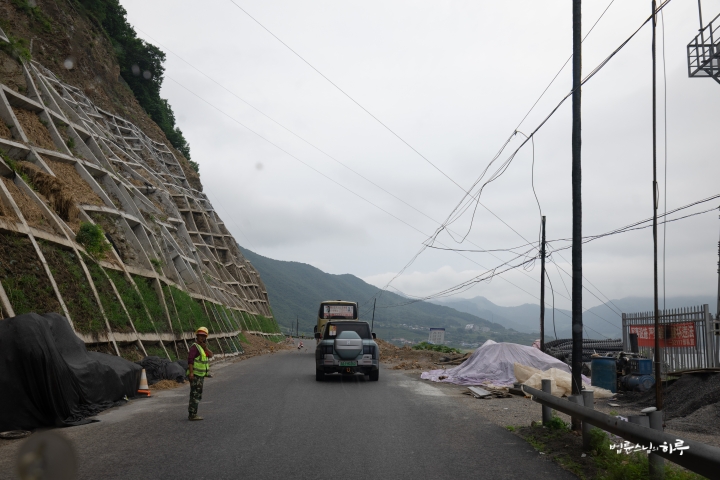
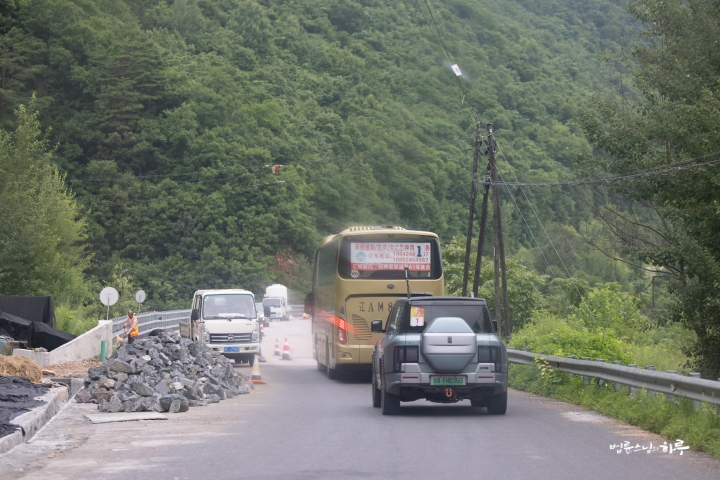
After consulting with the staff, Sunim announced the changed itinerary.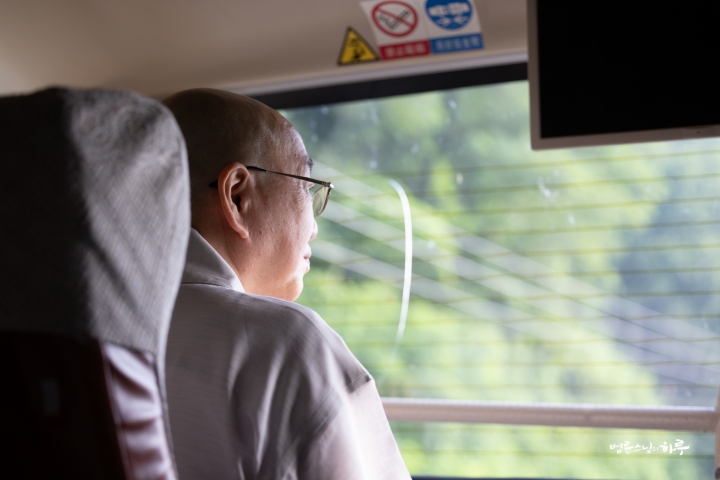
“Due to landslides caused by two days of rain, two or three sections of the Amnokgang(Yalu) River road to our destination, Changbai County, are blocked. The road to Linjiang is also cut off, and we tried to detour through local roads, but those have also collapsed due to landslides and are impassable. So we’re changing our plan to go out to Baishan City, take the highway toward Mount Baekdu, and then try to reach Changbai County. If we go this way, we’ll have to give up on seeing North Korean territory while traveling upstream along the Amnokgang(Yalu) River. However, if we reach Changbai County where the Glory Tower is located, we should be able to see North Korea’s Hyesan City. Of course, more variables might arise along the way, but that’s the nature of travel, so let’s proceed.
I’ve been leading history tours for over 30 years, and as time passes, China’s infrastructure keeps improving. However, controls are also becoming increasingly strict. It seems there are more places we can’t visit and greater restrictions. If you have opinions like ‘It would be better not to do history tours at all’ or ‘It’s still better to go despite these conditions,’ please share them. I’ll consider them for next year’s planning.” (laughter)
Regrettably, they had to abandon their original plan to travel upstream along the Amnokgang(Yalu) River and see North Korea from District 4 to District 18.
The bus turned around and headed for Baishan City on the western side of Mount Baekdu. Sunim introduced Professor Bang Hak-bong and Mr. Jo Chun-ho, who had made the greatest contributions to the history tours so far, and then explained in detail how support activities for North Korean refugees and humanitarian aid to North Korea had developed through these history tours.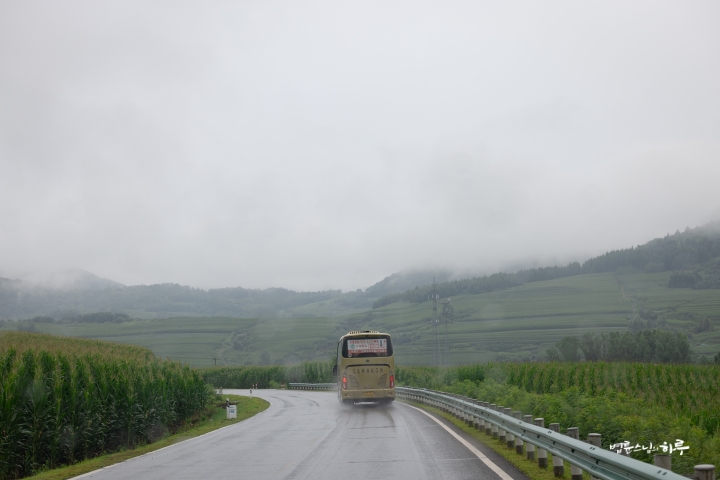
“In the early days of the Northeast Asian History Tour, the travel agency handling the guidance changed every year. It was during the summer of 1995 when we were doing a history tour and it had rained heavily. The person guiding us said he had been to North Korea. He said when he went there himself, the children were really small, and there were actually people starving to death. At that time, ethnic Koreans from China were beginning to come to South Korea, so I had heard that North Korea was economically struggling, but I asked, ‘No matter how bad it is, who would starve to death in this day and age?’ He said he had seen it with his own eyes. It was around the time I had started building schools for poor untouchable children in India, and when I showed him photos of Indian children begging, he said North Korea was even worse. When I didn’t believe him and said it didn’t make sense, he took me by boat to the Amnokgang(Yalu) River to show me. That was August 1996, and I was deeply shocked.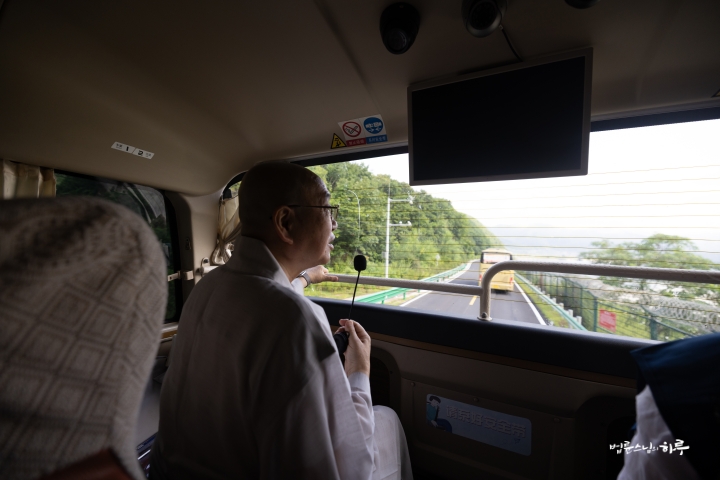
In September of that year, when I had business in the United States and visited LA, I gathered all available information related to North Korea. There was one bookstore that sold North Korean books, and I collected materials such as videotapes and newspapers. Through this research, I learned about the devastating floods that had struck North Korea in 1995. The reports indicated that the banks of the Amnokgang(Yalu) River had been transformed into what looked like sandy beaches.
Because People Were Starving to Death, I Could Not Stop.
On December 12, 1996, with Good Friends at the center, we established the ‘Buddhist Headquarters for Mutual Aid Among Our People.’ However, just as we were about to begin the North Korea aid movement after returning from the United States, the Gangneung submarine infiltration incident occurred. This incident led to a complete suspension of aid to North Korea, including from the Red Cross, and the Korean government halted support from all organizations that had been providing even modest assistance to North Korea. At that time, a pastor suggested, “Let’s not engage in the North Korea aid movement right now, but instead focus on helping Korean-Chinese fraud victims.” The scale of damage from Korean-Chinese fraud cases was enormous at the time. So we began activities to help victims earn money in Korea by meeting with Korean-Chinese leaders in China and discussing negotiation methods with the Korean government.
While the Korean-Chinese fraud victim issue certainly needed to be addressed, the famine situation in North Korea was extremely severe. Yet even those who had initially stepped forward to join the movement to help North Korean compatriots were all suspending their activities. But I thought about the starving child I had seen by the Amnokgang(Yalu) River – that child wouldn’t even know whether the Gangneung submarine incident had occurred or not. The reason for wanting to help North Korean compatriots was because that child was starving, and it wouldn’t be right to stop this work because of the Gangneung submarine incident, which had nothing to do with that child. People called me radical, saying “You shouldn’t do this now.” It was a time when people said anyone conducting fundraising campaigns to help North Korean residents would be arrested. With the mindset of “I don’t care if I get arrested,” I began fundraising activities in front of Seoul Station at the end of the year, together with others from Good Friends. Fortunately, I wasn’t arrested. (Laughter) 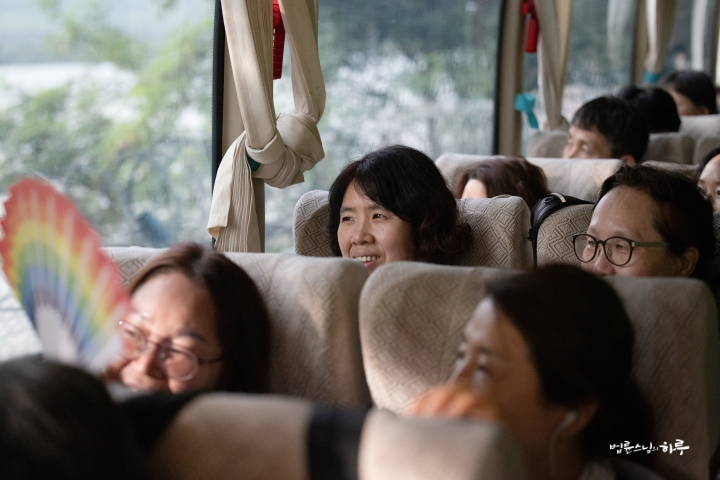
At that time, there was almost no information about North Korea. The people who had information were Dr. Stephen Linton of the Eugene Bell Foundation, who had information from his visits to North Korea, and Dr. Kim Jin-kyung, who founded Yanbian University of Science and Technology in China, also had information about North Korea. In 1997, we invited both of them to hear directly about the situation in North Korea. In March of the same year, when potatoes in Gangwon Province were overproduced and about to sprout in warehouses, we purchased about 1,960 tons to help both South Korean farmers and North Korean residents, sending them to North Korea by land in over 100 trucks. This marked the beginning of a full-scale movement to help North Korean compatriots.
Since entry into North Korea was not possible, I visited the field every month, surveying the Amnokgang(Yalu) River and Tumen River areas with the hope of finding even a glimmer of hope. During this time, I met many refugees who had crossed the border. Soon after, refugees began flooding to the border in enormous numbers.
So I proposed to help them together with ethnic Korean leaders in Yanji and other Tumen River border towns, whom I had come to know while helping ethnic Korean fraud victims. However, when the Chinese government banned such activities, everyone became scared and said they couldn’t do it. So I gathered them together and said, ‘I helped you when you were in trouble. But if you won’t help people in need now, isn’t that selfishness? Then I can’t help you either.’ After this persuasion, the Association of Ethnic Korean Fraud Victims stepped forward, and together they began systematically protecting, supporting, and helping people who had crossed over from North Korea.
‘Good Friends’ interviewed North Korean refugees and repeatedly reported on how many refugees there were, how many people had died in North Korea, and how severe the food shortage was. Thanks to the connections made while helping ethnic Korean fraud victims, ethnic Korean leaders organized activities across the entire region, connecting Hunchun, Wangqing, Tumen, Helong, Longjing, and Dunhua. The activities of helping and rescuing North Korean refugees numbered in the tens of thousands, just counting what was recorded.
To Prove That the Hunger of North Korean People Was Not a Lie
When I went to the United States to appeal about the severity of North Korea’s famine situation, South Koreans said, ‘North Koreans are bad people. It’s okay if they starve to death,’ yet they still participated in fundraising. However, Americans asked, ‘What’s the evidence?’ So to collect evidence, I sent a delegation back to the field to begin interviewing refugees. Through questions like ‘How many people died in your household over the past three years?’ and ‘How many died in your class?’, they secured interview data from about 270 people and took it back to the United States. But this time, they said the interviewed sample was too small to be statistically valid. After conducting additional research for another month and a half and bringing data from 470 people, they finally acknowledged it to some extent.
Andrew S. Natsios, whom I met at the time, was the representative of USAID and later served as vice president of World Vision. As a famine expert, after reviewing all the data, he determined that ‘it is indeed a famine situation,’ and through his arrangement, requested refugee assistance and humanitarian aid from the UN. It took about two years for this process to be formalized in the United States. In Korea, with the inauguration of the Kim Dae-jung government, international humanitarian aid was resumed, making a significant contribution to alleviating North Korea’s famine situation. At that time, many young college students suspended their studies to participate in refugee relief and investigation activities. Lee Seung-yong, who is in charge of the history tour, was one of them. However, he was eventually discovered by Chinese public security during support activities and had to be deported.
During that period, I brought U.S. congressional leaders to Yanji to meet refugees directly. After confirming the facts, the U.S. congressional leaders were able to recognize the severity of the problem. Andrew Natsios and I went all the way to Mount Baekdu and directly met refugees with worn clothes and tattered shoes to hear their testimonies. Through this process, we were able to prove that North Korea’s famine situation was not exaggerated and secure humanitarian aid. When reunification occurs, I believe that not only the North Korean government but also the South Korean government leaders who neglected this situation must be held responsible for the mass starvation in North Korea from 1995 to the early 2000s.
People Who Crossed the River of Blood and Tears
Most of the refugees who came to China were people who crossed the Tumen River. The river was narrow, there were many ethnic Koreans living across the river who could provide protection, and there were routes to the outside. But the most unfortunate people were those who crossed from Hyesan to Changbai. While it was easy to cross from Hyesan to Changbai, there was no way out of Changbai. At that time, there were no roads along the Amnokgang(Yalu) River, and the road from Linjiang to Changbai was so poor that it was difficult to arrive in a single day due to the long distance. 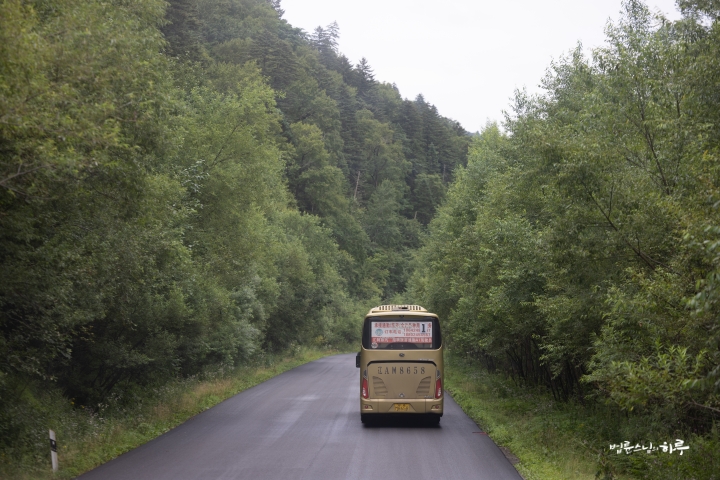
Another route was crossing Mount Baekdu through Manjiang to Erdaobaihe, but there was the Manjiang checkpoint. Mount Baekdu is a dense jungle forest, so it’s difficult to cross except by road. So refugees barely managed to cross Mount Baekdu but were all caught at the Manjiang checkpoint. That’s why North Korean refugees called the Manjiang checkpoint the ‘Manjiang of Blood and Tears’ at that time. If caught, they were detained or sent back. At that time, a leader in the ethnic Korean area appealed to me, saying, ‘What we’re doing is better work than anyone else’s, so why must we hide and do this work more nervously than criminals?’
I’ve made many preparations in my own way to ensure such tragedies never repeat, but currently, due to poor inter-Korean relations, we cannot take any action. Also, looking globally, it seems our reality is that we continue to turn away from tragedies that may be even worse than this, such as the disasters occurring in Gaza.”
While listening to Sunim’s explanation, they arrived in Baishan City.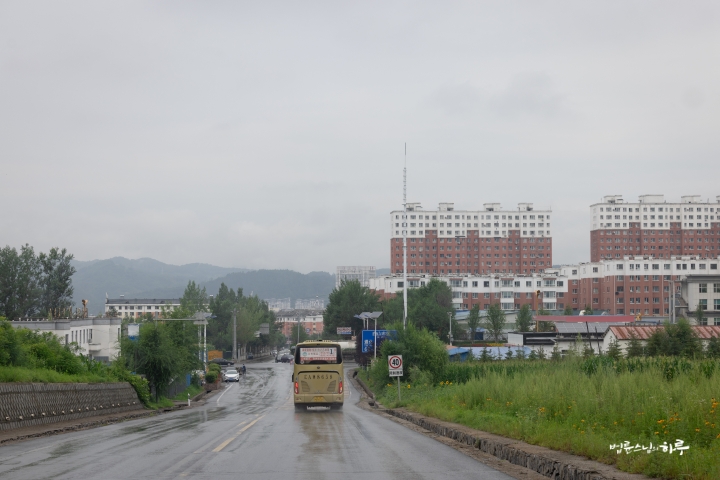
“Looking from Mount Baekdu as a reference point, to the east is Yanggang Province, to the north is the Korean Autonomous Prefecture, and to the southwest is Baishan. We have now arrived at Baishan City. From here, we’ll take the highway to Fusong. If we climb Mount Baekdu directly from Fusong, we’ll ascend to the western peak. Originally, we planned to go up along the Amnokgang(Yalu) River, but due to landslides, that plan was canceled, and we’re now moving to the west of Mount Baekdu. Shortly, when we reach the highland area, we plan to cross the pass of Mount Baekdu and enter from the east. Although we couldn’t follow the Amnokgang(Yalu) River as originally planned, we still intend to visit Hyesan City in the upper reaches of the Amnokgang(Yalu) River. After touring Hyesan City, we’ll climb Tapsan where the Yeonggwang Tower is located in Changbai across the river. After that, we’ll retrace our steps, move to the west side of Mount Baekdu, then go up to the north side to arrive at Erdaobaihe, completing today’s itinerary. The road we’re taking now is the path that people in the old days used to climb Mount Baekdu. So today’s itinerary can be called ‘a journey to find Mount Baekdu.'”
During the long drive, the tour group sang the song “Mount Baekdu” vigorously, feeling that they were heading toward Mount Baekdu. Sunim and the participants gazed endlessly at the scenery outside the window as if being absorbed into Mount Baekdu.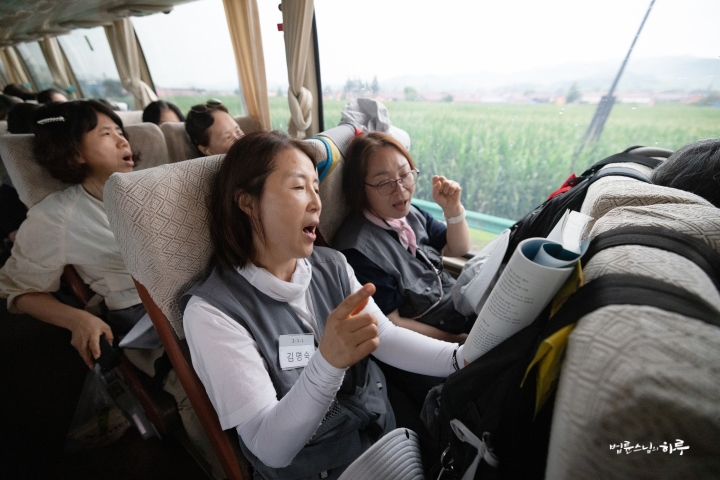
After eating the lunch boxes bought at the dawn market on the bus and enjoying the scenery outside, they arrived at the Changbai checkpoint at 1:30 PM. Public security officers boarded the bus, filming each person and asking for names and occupations. The inspection took longer, and the waiting time gradually increased. Eventually, they had to undergo inspection for two hours.
While waiting, Sunim told everyone to open their books and gave the lecture he was planning to give at the accommodation in the evening, using a transceiver on the bus.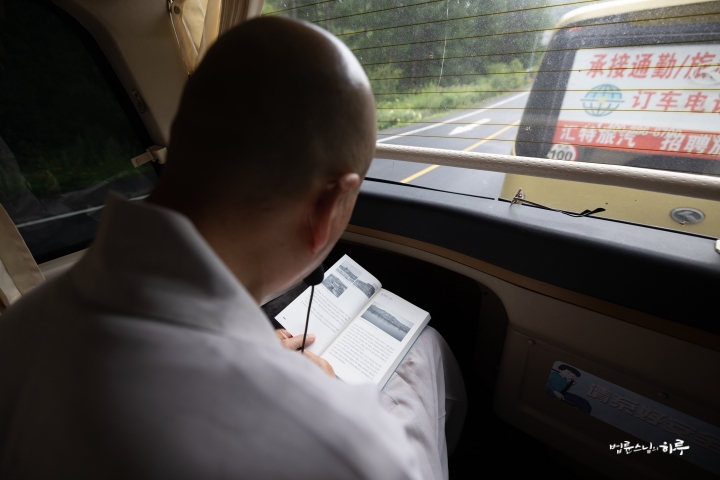
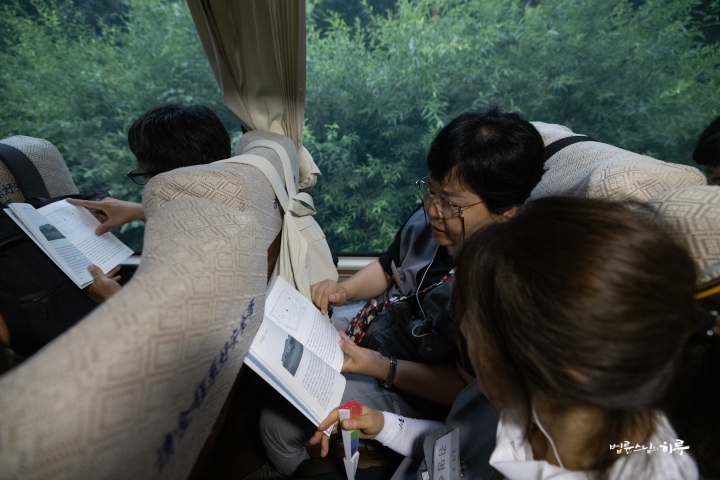
After explaining in detail about each region including Guodong Great Cave, Linjiang, District 8, Kimhyongjik County, Kimjongsuk County, Hyesan, Changbai, Yanbian Korean Autonomous Prefecture, and Erdaobaihe, he also talked about the topography and peaks of Mount Baekdu’s Cheonji (Heaven Lake) that they would climb tomorrow, and the historical background of how the border between North Korea and China was divided around Cheonji. Finally, he explained about the Yeonggwang Tower from the Balhae era that they would climb shortly.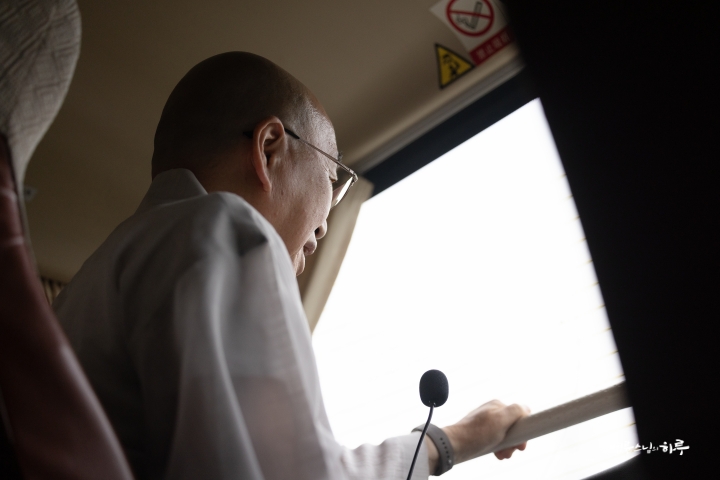
“The place we’re arriving at shortly is Tapsan in Changbai County. At the top of Tapsan stands the Yeonggwang Tower. The Yeonggwang Tower was built during the Balhae era, and this is the only one that remains intact to this day. The Yeonggwang Tower is not a Buddhist temple pagoda. Usually, temples have a main hall with a pagoda erected in front. But there’s no temple here. This is a tomb pagoda, a pagoda built on top of a tomb. Although most Balhae people were Buddhists, they followed the tomb style inherited from Goguryeo, creating underground tomb chambers and erecting pagodas on top. Such pagodas built on tombs are called ‘neungji pagodas’ (tomb pagodas). Although they were Buddhists, they made tombs according to their ancestral customs and erected Buddhist-style pagodas on top. There are no temple sites anywhere in this area. There’s a tomb underground with a pagoda erected on top, which is why the pagoda is slightly tilted.
There’s a similar pagoda in Gyeongju, though in a different style. King Munmu said he would become a dragon of the East Sea after death and asked for his cremated remains to be buried in the sea. The place where those remains were enshrined is Daewangam (Great King Rock). And at the cremation site, a pagoda was erected. It’s not a sarira pagoda of Buddha but a pagoda commemorating the king’s remains. This is also called a neungji pagoda. Since the tomb is in the sea and there’s no tomb on land, the pagoda serves as a substitute for the tomb. Balhae can be seen as having adapted this tradition in their own way.”
It was 3:40 PM when they finally finished the inspection and the bus departed again. After traveling for about 50 minutes, the Amnokgang(Yalu) River appeared again.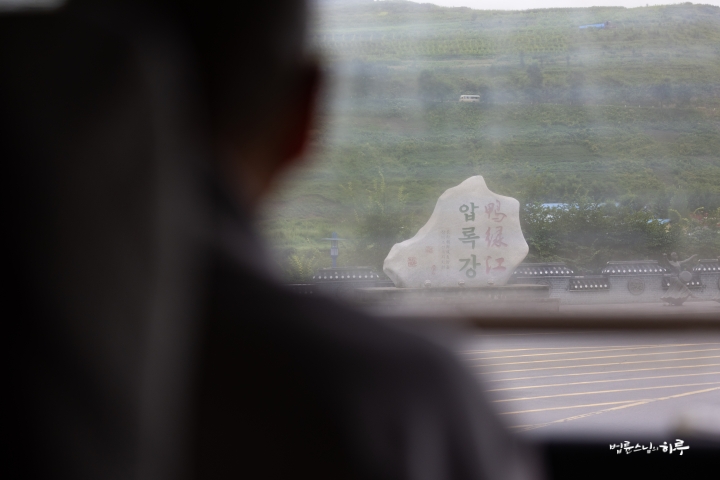
Not long after following the Amnokgang River, North Korea’s Hyesan City appeared so close across the river that it seemed within reach. The river was as narrow as a stream, making it feel like it could be crossed in just a few steps.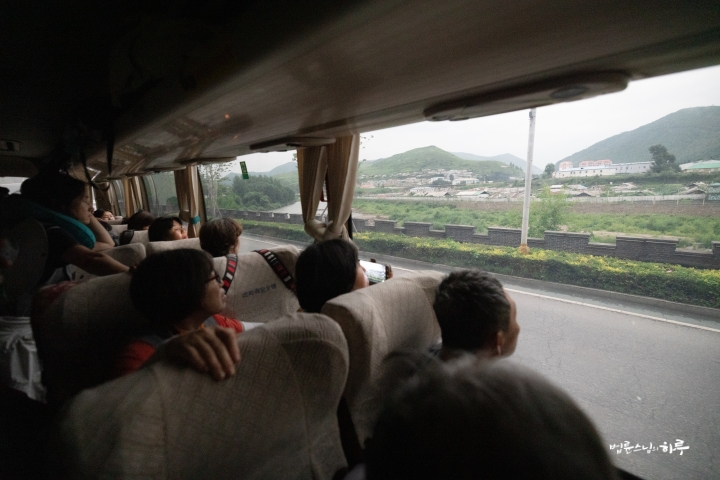
Sunim was amazed at the changed appearance of Hyesan City, saying it was like heaven and earth had been transformed.
“The land you see ahead is North Korea’s Hyesan. Please look out the window. This river is very narrow. All the fields you see across there are North Korean land. The village you see ahead is also a North Korean village. When the weather is hot, many people gather by the riverside, but today there’s no one, perhaps because of the rain.
Yesterday and Today of North Korea Seen Across the Amnokgang(Yalu) River
Looking at the mountains, there’s not a single tree. In Hyesan, people have to get wood themselves to make fires, but since there are no trees in this area, they sometimes have to walk as far as 40 li (about 16 km) to gather wood. 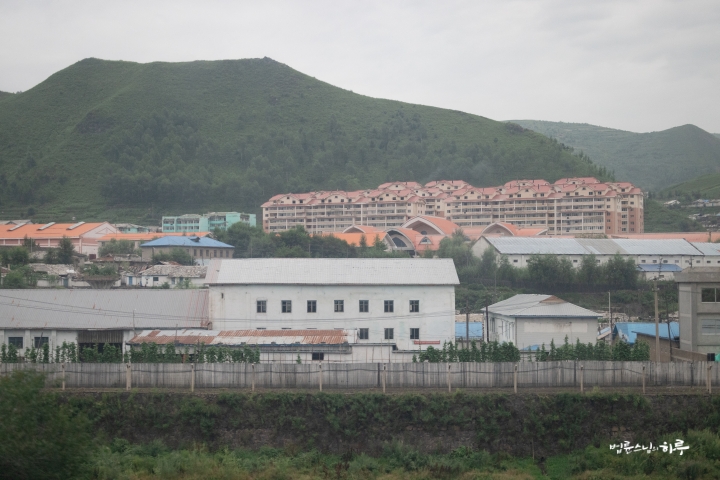
New apartments have been built over there. This place had no changes for 30 years, but in the past 5 years, quite a lot of civil engineering and construction has taken place. Not just in Pyongyang but even in these provincial cities. I can see someone walking along the riverside.
We Met Refugees Who Crossed the Border Here
When I first surveyed this place around 1998, there were many people out on that gravel and dirt riverbank. While I was looking across the river, I witnessed a woman holding a small child fall backward. She had collapsed from starvation.
In the morning, two women came out of the warehouse of the house where we were staying, soaking wet. They had crossed the river the night before and were hiding in that warehouse. I gave them food and money and sent them back. One woman I encountered two or three times like this, I later met in Daejeon. When I asked ‘What brings you here?’, she said she had eventually defected and entered South Korea. She was a woman in her mid-thirties at the time, and when she hugged me and cried, wouldn’t the people around us have looked at us strangely? (laughter) 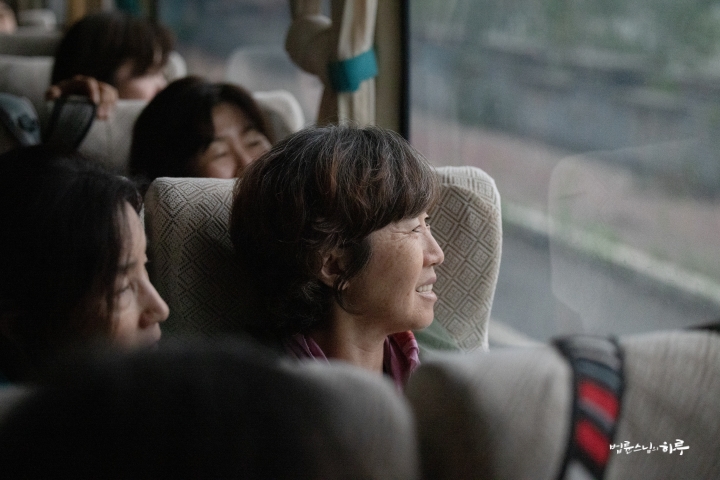
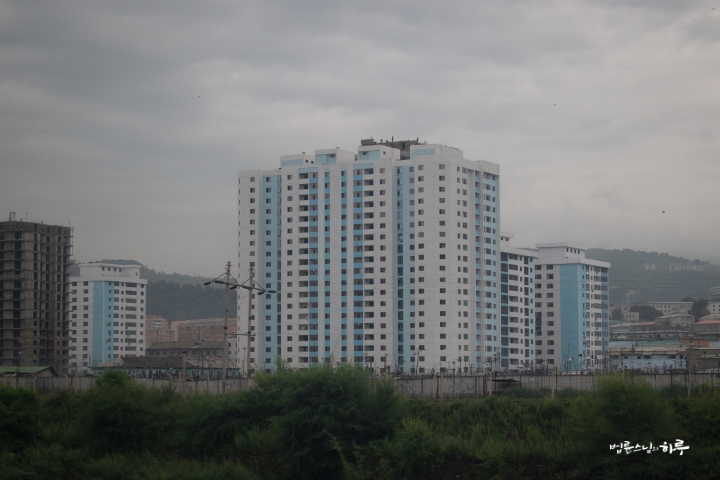
That building in the back is also newly constructed. Coming back after 5 years, it’s truly a whole new world. Was it worth all the trouble to come here?”
“Yes.”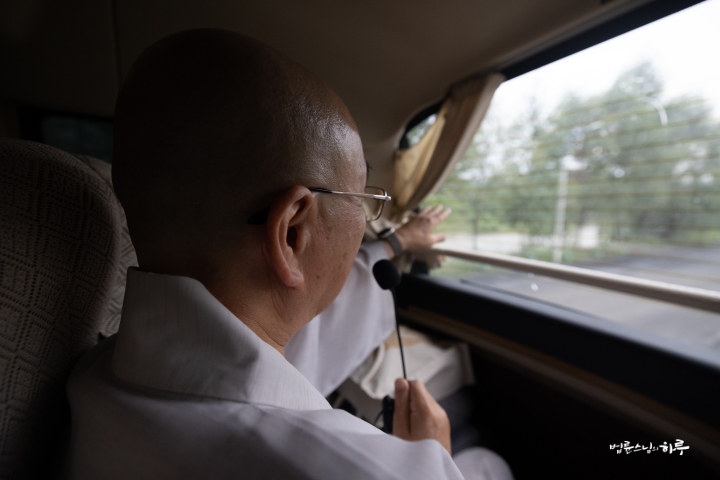
“In the past, during summer, people would gather by this riverside to do laundry and fetch water. The water supply system was completely broken back then. There would be dozens, sometimes hundreds of people here. But now there’s no one, which means the water supply system has been restored.
Even during the Arduous March in the mid-1990s, there were many North Korean children and refugees in the cornfields and forests deep in these valleys. This place is easy to cross into but there’s nowhere to escape. There are only two routes – the path over Mt. Baekdu that we just crossed and the route toward the Amnokgang(Yalu) River. Each route has checkpoints that are very difficult to avoid. Eventually, countless people lost their lives fleeing into the mountains. This area isn’t a place where you can find a road just by crossing one pass. There are absolutely no other connecting roads for hundreds of miles in every direction.”
After viewing North Korea’s Hyesan City up close, the group arrived at the foot of Yeonggwang Tower at 5 PM.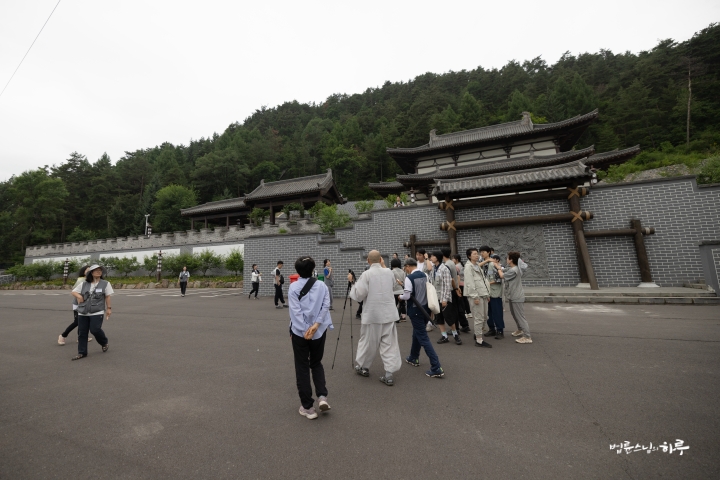
“We were originally supposed to arrive at Yeonggwang Tower by 1 PM according to our schedule, but after being inspected twice and taking a detour, it took us 4 extra hours.”
After getting off the bus, the group slowly walked up toward Yeonggwang Tower. Instead of the steep stairs they usually climbed, they followed a new path made of wooden decking. While it was easier to walk, it took quite some time to climb as they had to go around.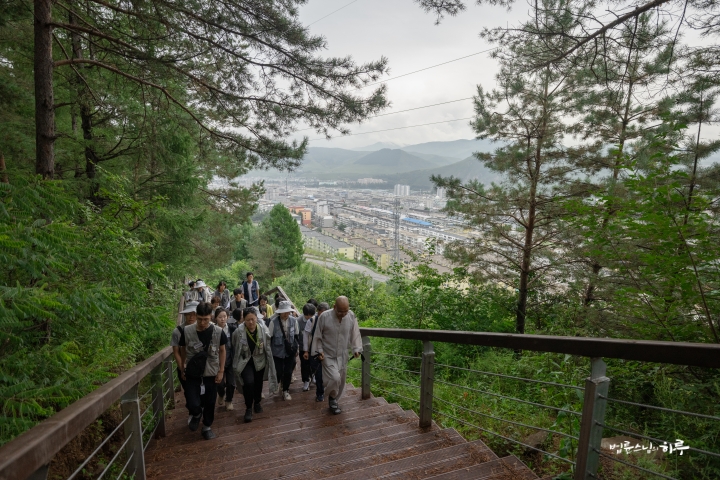
Sunim led the way at first but due to pain in his heart and legs, he sent the group ahead and slowly followed behind them.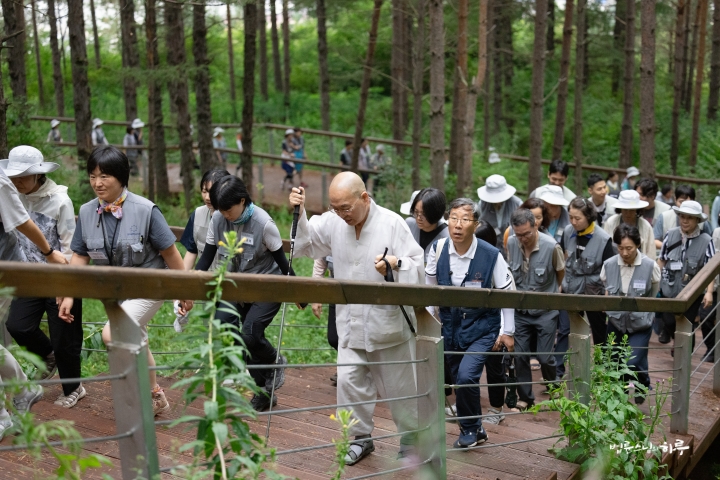
The group that arrived first listened to an explanation about this place from Lee Seung-yong of Good Friends. Looking out over Hyesan, the capital of Yanggang Province, they heard stories about how Good Friends helped North Korean refugees here 25 years ago. Hearts grew heavy hearing about how they helped cold and hungry refugees despite threats to their own safety.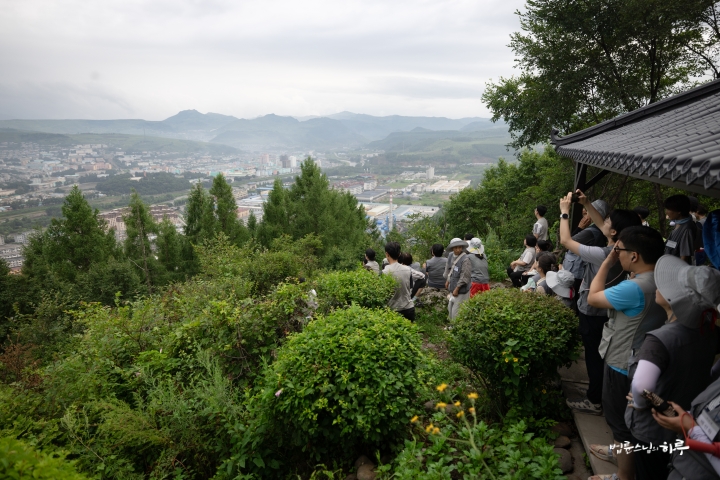
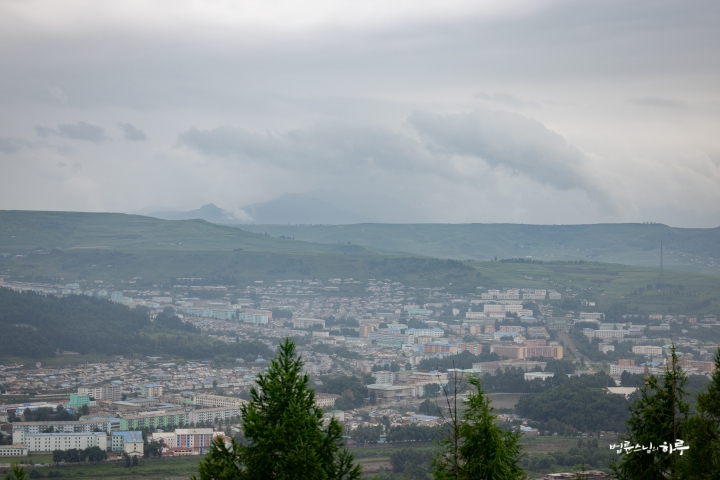
Sunim arrived later and quietly offered three prostrations in front of Yeonggwang Tower before praying.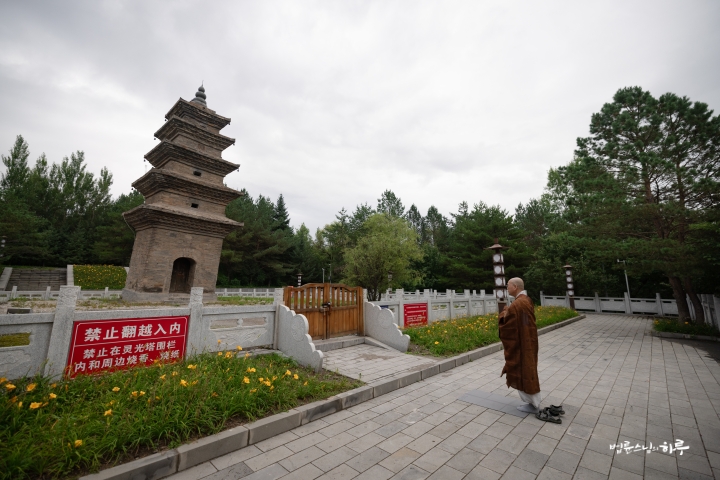
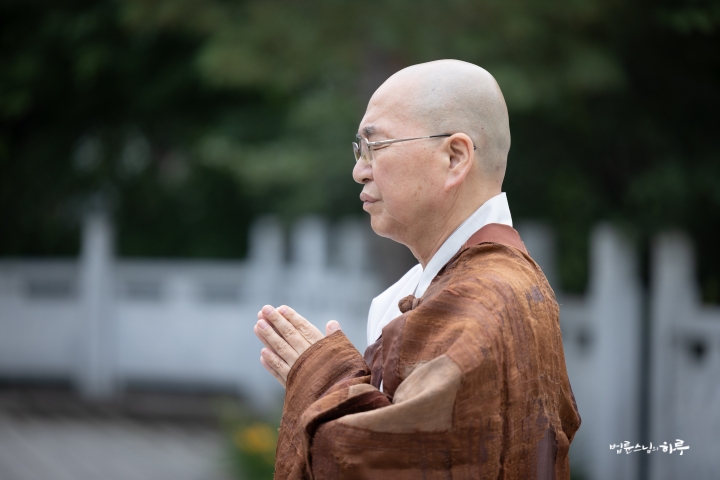
After Lee Seung-yong finished his explanation, everyone gathered again in front of Yeonggwang Tower to recite the Three Refuges and the Heart Sutra.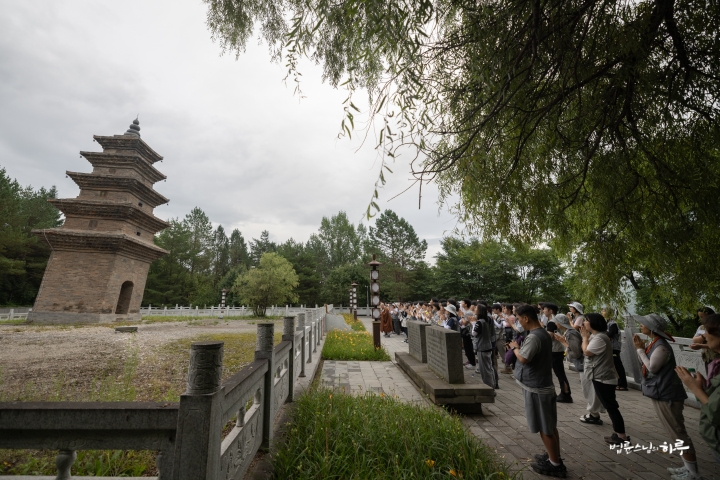
Sunim offered a heartfelt blessing prayer for the tour group.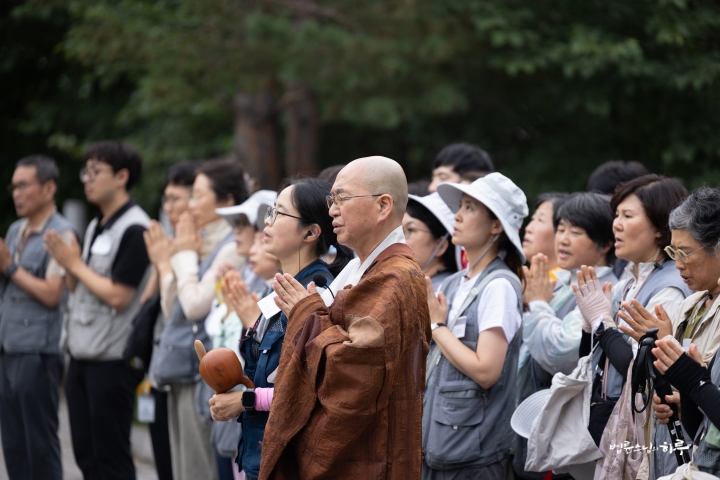
“Holy Buddha, Great Compassionate Avalokitesvara Bodhisattva, Great Vow Ksitigarbha Bodhisattva! Today, all of us on the Northeast Asian History Tour offer our prayers before the ancient Yeonggwang Tower of Balhae. Hwanin the Heavenly God, Hwanung the Heavenly Emperor, Dangun Wanggeom, and all the ancestral spirits of our nation! Please watch over us until the day when the Korean Peninsula is peaceful and the South and North become one. May the blessings of all Buddhas and Bodhisattvas fill this group visiting here 1,000 years after the fall of Balhae, so that everyone may complete this journey in good health without any problems. May all Buddhas and Bodhisattvas bear witness, and may the Eight Legions of Devas and Nāgas protect and support us.” 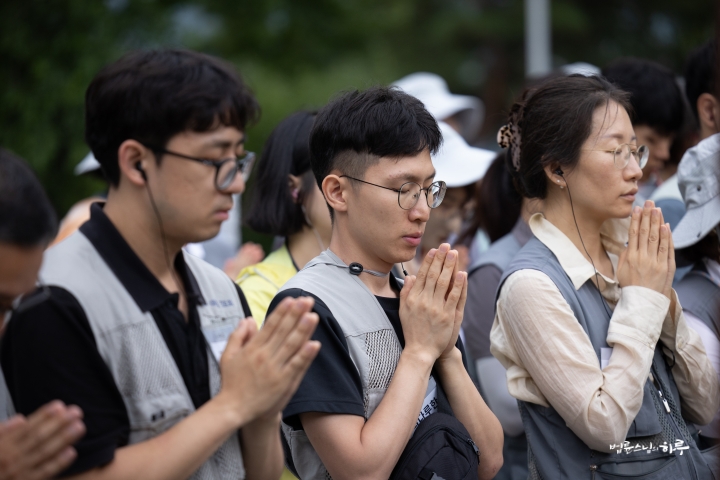
The group also joined their hands in prayer, vowing to inherit the spirit of the Balhae people who roamed the Manchurian plains and to open a new unified Korea.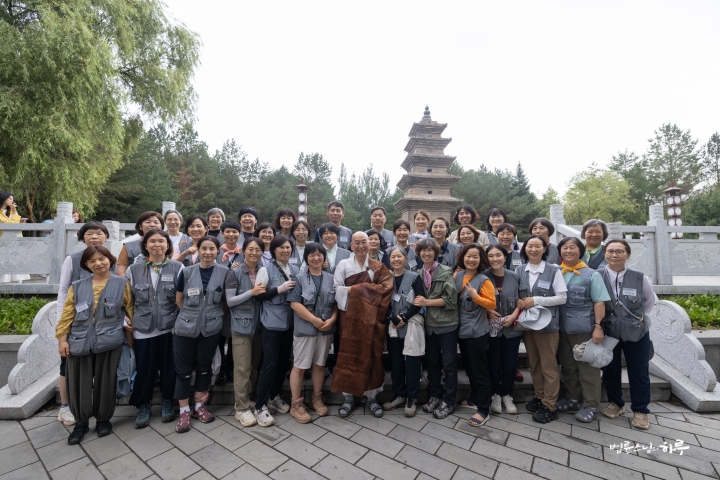
After taking a group photo together, they began descending at 6 PM. On the way down, they took the steep stairs.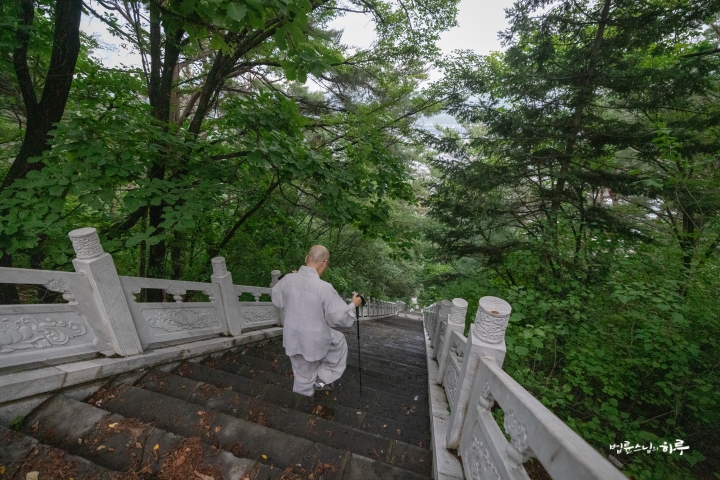
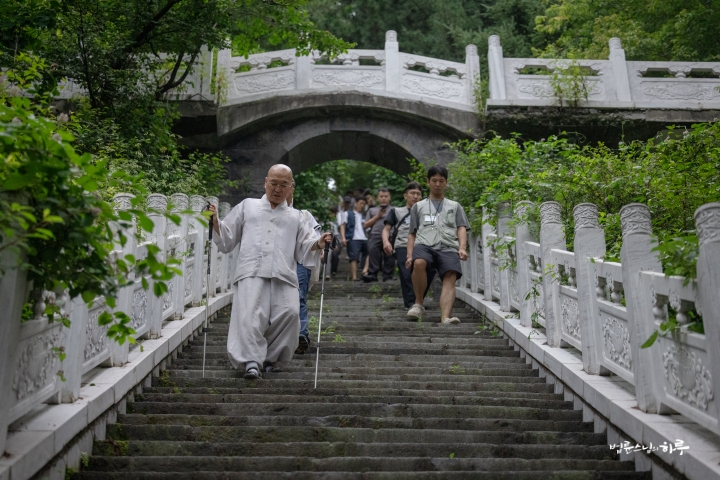
The bus now headed toward Mt. Baekdu.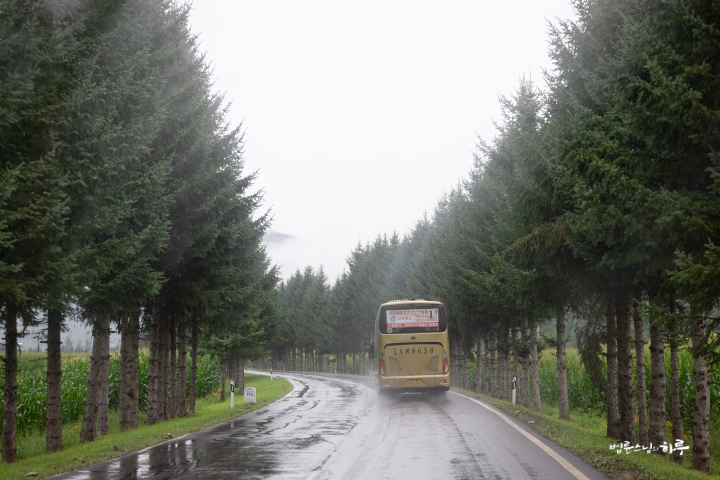
“It looks like it will be past 11 PM when we arrive at Erdaobaihe. Let’s cancel the evening lecture, and please get plenty of sleep on the way.”
As they began driving through the deep mountains of Mt. Baekdu, the sun quickly set. The group slept soundly on the bus.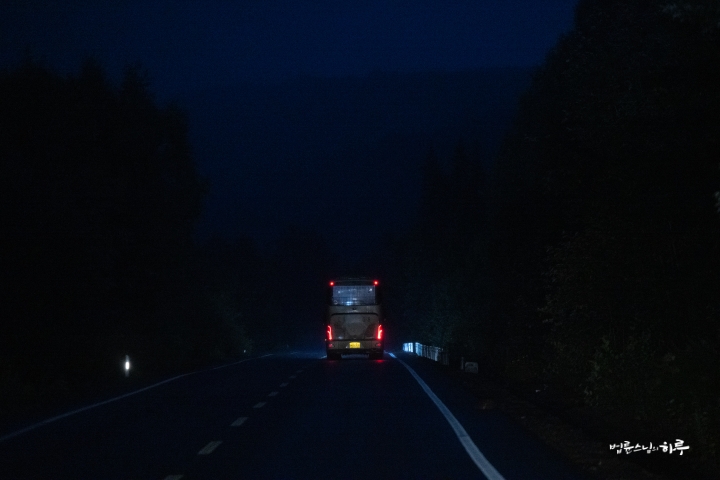
After a 5-hour bus ride, they arrived at Erdaobaihe at 11 PM. They first went to the restaurant for a late dinner. Before eating, Sunim spoke.
“Did you sleep well on the bus?”
“Yes.”
“Thank you for your hard work on the long journey. Don’t complain later that you only got 2 hours of sleep after arriving at midnight when you slept soundly on the bus. They say we can’t cancel the restaurant because we made a reservation in advance. So have a spoonful of rice and go to sleep. Just because we arrived late tonight doesn’t mean we can depart late tomorrow. We’ll stick to the plan – wake up at 4:20 AM, depart at 5 AM. However, there’s no breakfast tomorrow, and we won’t be able to eat until around 2 PM. If you have complaints, you may speak up, but only if you’re older than me.” (laughter)
Although it was past 11 PM, everyone recited the meal verse together and enjoyed their dinner.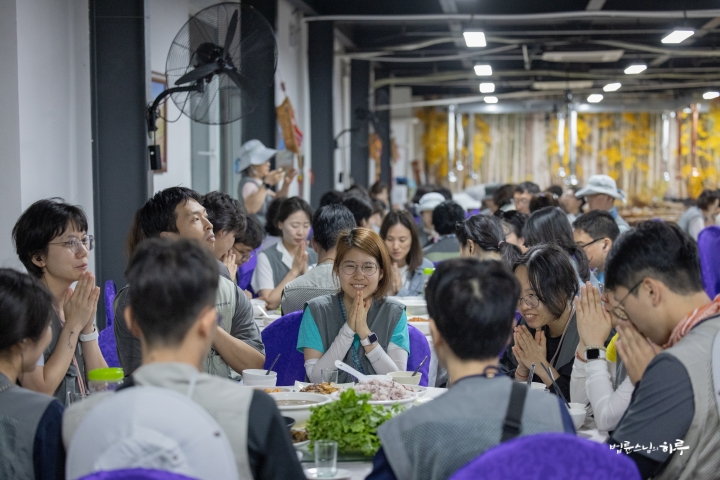
Sunim expressed his gratitude to the drivers who had worked hard driving all day.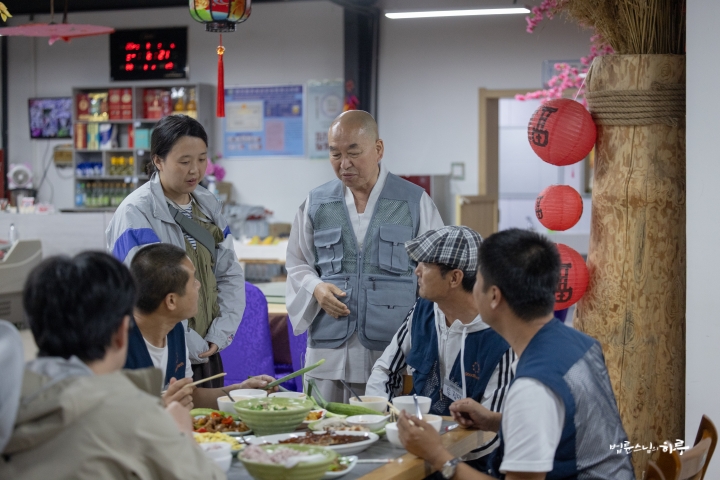
“Since we travel to remote areas, our drivers have a tough time. Please give a big round of applause for our drivers who worked harder than anyone today.” 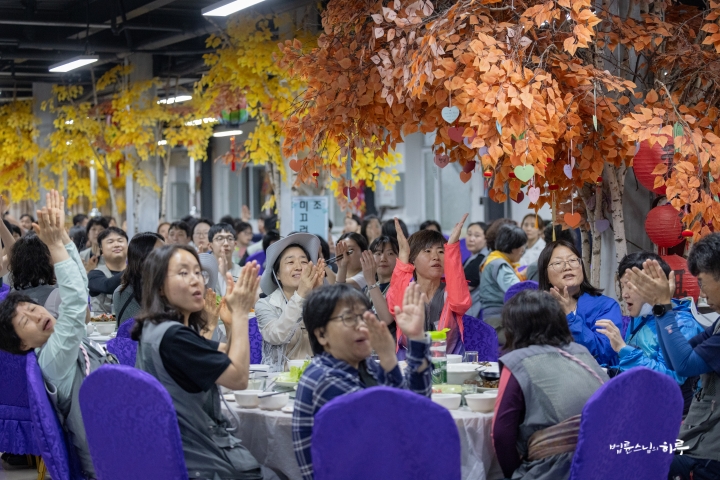
After finishing the meal and moving to their accommodations, it was past midnight. Since they need to wake up at 4:20 AM tomorrow to go to Mt. Baekdu, everyone caught a brief nap.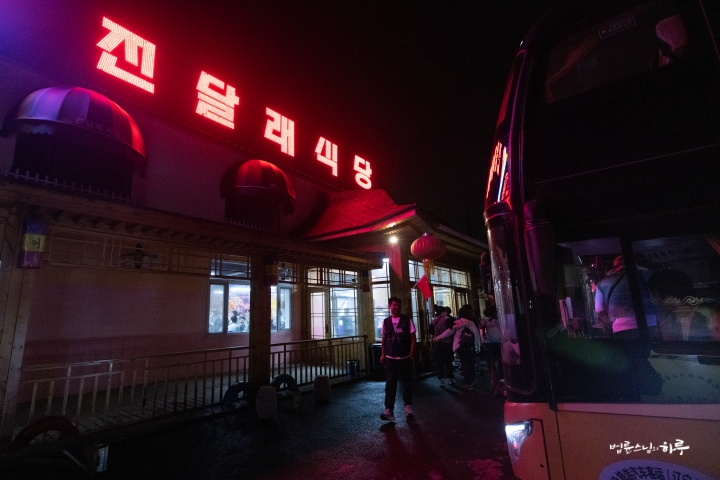
Tomorrow is the 4th day of the Northeast Asian History Tour. In the morning, they will climb to Mt. Baekdu’s Cheonji (Heaven Lake), visit Biryong Falls, Small Heaven Lake, Nokyeondam, and the Underground Forest in order, then descend. In the afternoon, they will tour the Cheongsanri Battle Site and enter Hualong.



